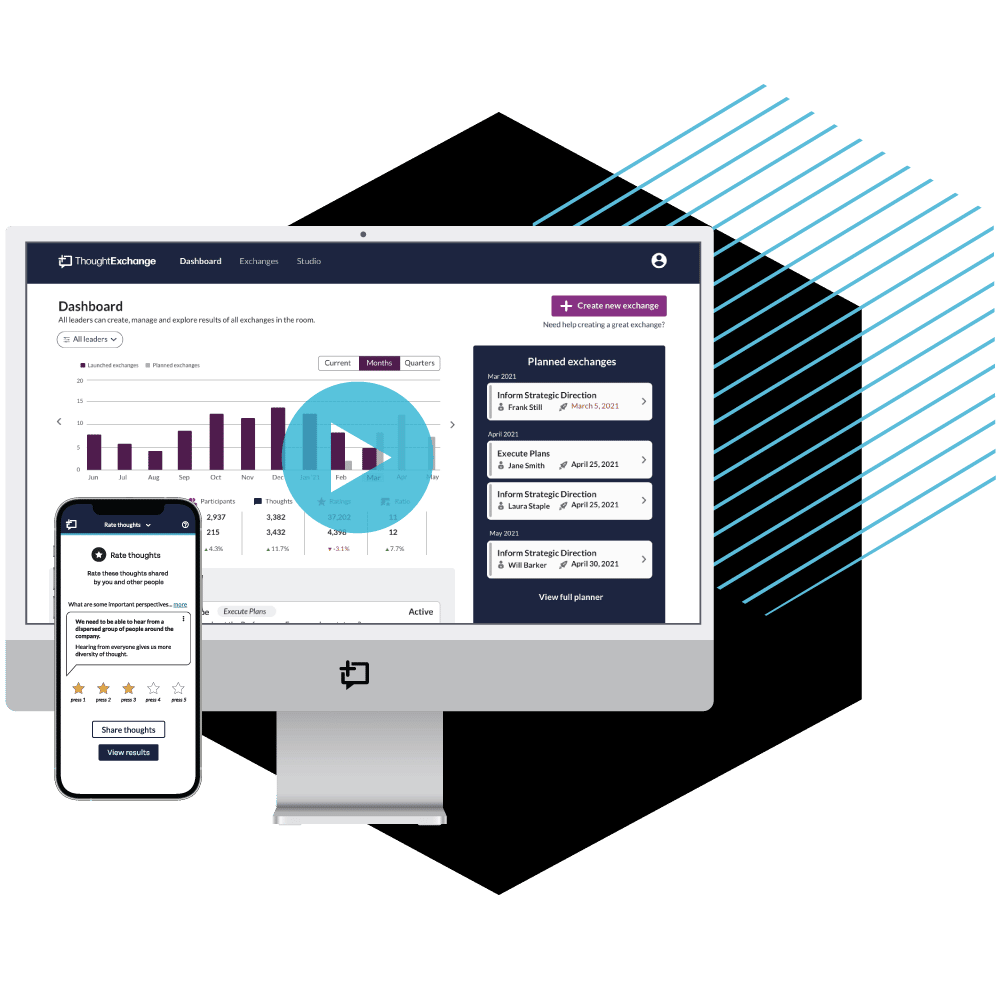August 10, 2022
Meghan MacRae
So You’ve Done a Survey… Now What?
14 minutes
You’ve run your employee engagement survey, and your results are in. You know the strength of your employees’ agreement or disagreement with each statement, but you’re in the dark as to why they feel that way.
Maybe you asked some open-ended questions and got lots of quality responses telling you how employees feel and why. But you’re now overwhelmed with data that’s going to take weeks to sort through and make sense of.
We know that surveys are an important part of an effective employee engagement strategy. They help employees feel heard, and help leaders understand, predict, and even influence employee behavior, according to Harvard Business Review.
They also have their drawbacks. By only allowing employees to choose from available options, you’re manufacturing consent for the most popular selection. Your employees may be choosing the option they dislike the least, rather than an alternative they’d actually prefer.
The benefits and drawbacks of surveys
What's good about surveys
What's missing from surveys
When it comes to understanding the benefits and drawbacks of surveys, we like to use the wedding dinner analogy. When your guests RSVP, they’re given the option of chicken, fish, or vegetarian. A beef lover may have to settle for chicken because it’s the option they dislike the least. They may be grateful for the free meal, but they might not be as happy eating it.
When it comes to employee experience or strategic decision-making, choosing the least-liked option isn’t ideal for engagement or productivity. Since we know that 87 percent of employees aren’t fully satisfied with their employee experience, it’s important to give employees opportunities to have their ideas and insights heard and acted on by leadership. A survey alone may not provide those opportunities in the most effective, efficient, and equitable way.

How to make surveys even better
Surveys have proven value, and they make it easy to get a quick read on your employees. They’re a staple of most HR departments and employee engagement efforts, and your organization is probably already invested in survey technology. However, the gaps and potential bias in survey data mean you won’t get the full picture of your employees, making it difficult to find effective solutions to their challenges—and get the full ROI on your surveys.
Let’s look at three of the most common types of employee surveys. According to SHRM, these are:
- Employee opinion and satisfaction surveys: Surveys that measure employee views, attitudes, and perceptions of their organization (also known as "climate surveys").
- Employee culture surveys: Surveys that measure the point of view of employees and is designed to assess whether it aligns with that of the organization or its departments.
- Employee engagement surveys: Surveys that measure employees' commitment, motivation, sense of purpose, and passion for their work and organization.
Each of these surveys gives leaders a big-picture view of how their employees interact with their employer brand, workplace culture, and the business purpose and strategy. They’re easy to set up and replicate to compare year-over-year.
But before, during, and after the data is collected via surveys, leaders need tools to help them determine what they need to ask, understand the specifics of any challenges or opportunities that arise, as well as explore solutions that will garner employee support. We’ll look at how to do that using ThoughtExchange, the world’s number one Enterprise Discussion Management tool.
ThoughtExchange allows you to:
- Gather detailed answers to an open-ended question
- Avoid bias in asking, answering, and assessing responses
- Gauge sentiment among participants, not just answer frequency
- Find areas of common ground and disagreement within the group
- Quickly analyze responses and identify actions

Before you survey
It’s common for employee engagement surveys to ask the same questions, year in and year out. While it makes sense to build up datasets, this repetition doesn’t take into account the changing market or social conditions that impact your employees and business.
Incorporating ThoughtExchange into your survey processes will ensure you’re asking the right questions at the right time, so you’re not left with thousands spent on useless data. Using ThoughtExchange with your employees prior to sending out your survey allows you to access important preliminary data.
Run an Exchange with employees to:
- Prioritize survey topics. Get input on what’s top of mind for your employees, and what isn’t a priority.
- Determine common ground. For tougher, more polarizing conversations, identify the areas where employees agree to focus your efforts on problem-solving.
- Remove bias. Find out the options your employees support before you survey them for the most popular choice.
While you survey
Surveys are built to give you simple, concise data points, but their qualitative functions are sometimes lacking. Instead of including an open-ended question in your survey—and outputting spreadsheets of answers for a data analyst to make sense of—run an Exchange to complement the survey. Built-in analytics make it easy to understand the most important ideas, instead of just the most frequently mentioned ones.
An Exchange also creates stronger alignment around highly-rated ideas. Not only do participants have the opportunity to anonymously rate their colleagues’ ideas, but the process also offers transparency in the decisions you make based on the results.
After you survey
Generally, surveys ask employees to rate statements about their engagement and satisfaction at work on a Likert scale from Strongly Disagree to Strongly Agree. This gives leaders a blanket idea of where their employees may be struggling to connect with the organization and their work, and where they’re excelling. However, it doesn’t help leaders understand the specific actions that will improve their experience at work.
After running an employee opinion and satisfaction survey, employers can take the areas where their employees have identified challenges and use an Exchange to explore each of these areas. For example, a significant number of employees in a particular department may have reacted negatively to the statement, “this organization appreciates new ideas.” Using an Exchange, leadership can ask employees to elaborate on why they feel their ideas aren’t being heard, and what solutions appeal to them.
Survey results may also show differences in priorities from team to team. Using team-specific Exchanges, leaders can run deep dives into the unique issues their teams face and determine their priorities.
What follows is a candid, collaborative discussion where leaders are able to identify the “why” behind their survey responses. Using advanced analytics, leaders can identify the issues that matter most to their employees, and the solutions that appeal to the majority of their participants. Employees feel respected and heard, and leaders come away with a list of the most supported actions in hand.
Engagement that boosts retention
Surveys are a popular way of engaging employees, but often organizations leave their engagement efforts there. One Forbes study showed that among their respondents, “58% of companies are not taking meaningful action on the data from their employee engagement surveys.” If organizations want to engage, retain, and involve employees in business objectives and outcomes, they have to demonstrate they are soliciting employee feedback and acting on insights to improve.
HBR recently looked at the ways in which tech interfaces employee experience in the hybrid workplace, and they noted that two-way communication between employees and their leaders and transparency in decision-making are essential for your employee experience. Ensuring that leaders consult their employees and act on their insights is even more vital in a digital environment. “All employees have valuable insights and feedback to share that could improve the collective workplace experience,” the authors explain, “so it’s critical leaders look at the complete picture rather than making decisions in a silo.”
In the current workplace environment, employees are increasingly expecting their leadership to listen, and they’re leaving when they don’t feel that’s happening. And our recent research on Gen Z in the workplace found that employees who don’t feel heard at work were six times more likely than those who feel heard to say that they are already looking for a new job.
Research shows that employees are eager to provide feedback to their employers, to feel like their voice is valued by leadership, and to see their feedback translated into meaningful action. If that isn’t happening at their organization, they’re looking to the competition.

Supercharge your surveys with ThoughtExchange
The employee engagement tools you use speak volumes about the employee experience you intend to provide. An enterprise discussion management tool like ThoughtExchange is intended for two-way communication. Employees can communicate their perspectives clearly to leadership and to each other, and leaders are able to respond to their actual ideas and needs rather than assuming them based on general survey data. ThoughtExchange facilitates collaborative, asynchronous communication, and makes it simple to distill qualitative and quantitative data into meaningful and actionable results.
Benefits of ThoughtExchange
- Gives people the ability to answer in their own words, not pick the closest response
- Participants share their own answers and rate others, so you get a more accurate view of the group’s priorities
- Make decisions based on the highest-rated, most supported ideas—like a focus group, but with everyone
- Built-in tools help you analyze and understand responses in minutes or hours
- Use automated reporting to export PDFs and slides, or share the conversation and results in real-time
- Easily replicate and repeat the discussion at scheduled intervals to build a robust data set that can be efficiently cross-analyzed within the product
As for the drawbacks? Maybe we’re biased, but there aren’t many. If your leadership isn’t interested in hearing their employees' innovative ideas, or in improving employee engagement with and loyalty to the organization, ThoughtExchange may not be right for them. But even the most stubborn of old-school leaders can be swayed by numbers—and it’s been proven time and again that employees who feel valued, aligned, and engaged by their organization translate into better financial results and lower attrition costs.
Don’t just take it from us—check out how our customers use ThoughtExchange to explore and improve their employee survey results.
Customer Spotlight
A financial services company consistently ranked high on the annual Great Place to Work® Survey, but was looking to do better. Their survey results showed that overall, their employees had high satisfaction, but there were still areas where they could improve. It was difficult for individual department leaders to pinpoint the expectations of their teams, so they turned to ThoughtExchange.
Using a series of Exchanges within individual departments, leaders were able to consult their teams about each of the areas that needed improvement. By gathering their team’s collective insights on each topic, they were able to align strategically based on what their employees flagged as most important. Their employees were involved in the decision-making process, helped ideate and implement new programs, and above all, saw their perspectives included and valued by their leadership.
The following year, the company improved its Great Place to Work® ranking by seven places.



